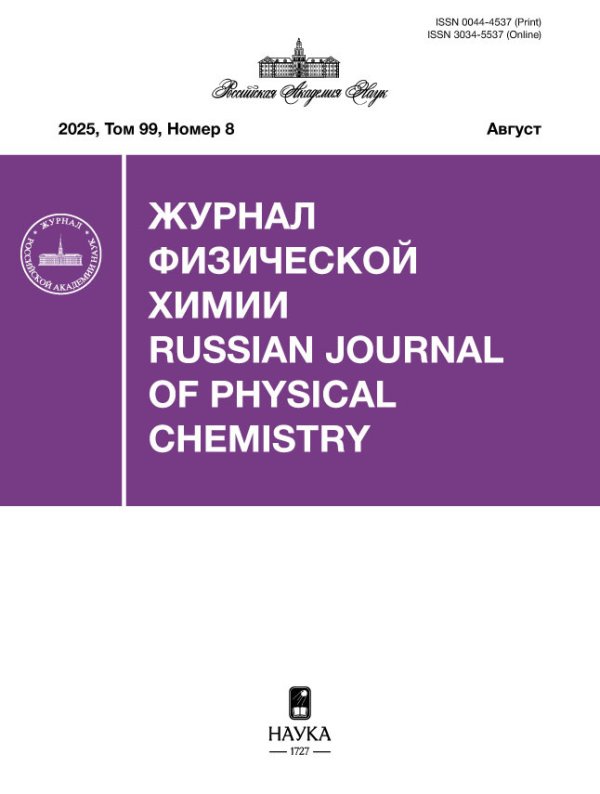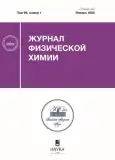Kinetic model of the temperature-programmed desorption of ammonia to study the acidity of heterogeneous catalysts
- Authors: Lysikov A.I.1,2, Vdovichenko V.A.1,2, Vorob’eva E.E.1,2, Shamanaeva I.A.1,2, Luzina E.V.1,2, Piryutko L.V.1, Veselovskaya Z.V.1,2, Parkhomchuk E.V.1,2
-
Affiliations:
- Boreskov Institute of Catalysis SB RAS (IC SB RAS)
- Novosibirsk State University (NSU)
- Issue: Vol 99, No 1 (2025)
- Pages: 50-67
- Section: CHEMICAL KINETICS AND CATALYSIS
- Submitted: 01.06.2025
- Published: 17.04.2025
- URL: https://innoscience.ru/0044-4537/article/view/681868
- DOI: https://doi.org/10.31857/S0044453725010053
- EDN: https://elibrary.ru/EISYVY
- ID: 681868
Cite item
Abstract
A new method for processing the results of the temperature-programmed desorption (TPD) of ammonia from heterogeneous catalyst surfaces and an approach for automatic deconvolution of TPD kinetic curves are proposed. This method uses the Polanyi-Wigner kinetic model with formal kinetics approaches for simple reactions, which imposes restrictions on the observed orders of 1, 2, or 3. The parameters of TPD curves are selected based on the inverse simulation using the Runge-Kutta method and fitting them to experimental points using dynamic model parameters changes. As an example, several heterogeneous catalysts are presented in this work. TPD-NH3 of titanium silicalite-1 and silicalite-1 is obtained using one third-order desorption kinetic equation. TPD-NH3 of the three samples of γ-alumina is obtained using two desorption peaks with similar kinetic parameters.
Full Text
About the authors
A. I. Lysikov
Boreskov Institute of Catalysis SB RAS (IC SB RAS); Novosibirsk State University (NSU)
Author for correspondence.
Email: lyanig@catalysis.ru
Russian Federation, Novosibirsk, 630090; Novosibirsk, 630090
V. A. Vdovichenko
Boreskov Institute of Catalysis SB RAS (IC SB RAS); Novosibirsk State University (NSU)
Email: lyanig@catalysis.ru
Russian Federation, Novosibirsk, 630090; Novosibirsk, 630090
E. E. Vorob’eva
Boreskov Institute of Catalysis SB RAS (IC SB RAS); Novosibirsk State University (NSU)
Email: lyanig@catalysis.ru
Russian Federation, Novosibirsk, 630090; Novosibirsk, 630090
I. A. Shamanaeva
Boreskov Institute of Catalysis SB RAS (IC SB RAS); Novosibirsk State University (NSU)
Email: lyanig@catalysis.ru
Russian Federation, Novosibirsk, 630090; Novosibirsk, 630090
E. V. Luzina
Boreskov Institute of Catalysis SB RAS (IC SB RAS); Novosibirsk State University (NSU)
Email: lyanig@catalysis.ru
Russian Federation, Novosibirsk, 630090; Novosibirsk, 630090
L. V. Piryutko
Boreskov Institute of Catalysis SB RAS (IC SB RAS)
Email: lyanig@catalysis.ru
Russian Federation, Novosibirsk, 630090
Zh. V. Veselovskaya
Boreskov Institute of Catalysis SB RAS (IC SB RAS); Novosibirsk State University (NSU)
Email: lyanig@catalysis.ru
Russian Federation, Novosibirsk, 630090; Novosibirsk, 630090
E. V. Parkhomchuk
Boreskov Institute of Catalysis SB RAS (IC SB RAS); Novosibirsk State University (NSU)
Email: lyanig@catalysis.ru
Russian Federation, Novosibirsk, 630090; Novosibirsk, 630090
References
- Da Ros S., Barbosa-Coutinho E., Schwaab M. et al. // Mater. Charact. 2013. V. 80. P. 50.
- Phung T.K., Garbarino G. // J. Ind. Eng. Chem. 2017. V. 47. P. 288.
- Yashnik S.A., Boltenkov V.V., Babushkin D.E. et al. // Kinet. Catal. 2022. V. 63. P. 555.
- Cvetanoviĉ R.J., Amenomiya Y. // Adv. Catal. 1972. V. 6. P. 21.
- Amenomiya Y., Chenier J.H.B., Cvetanović R.J. // J. Phys. Chem. 1964. V. 68. P. 52.
- Serebrennikov D.V., Grigor’eva N.G., Khazipova A.N. et al. // Kinet. Catal. 2022. V. 63. P. 577.
- Wu L., Su H., Liu Q. et al. // Ibid. 2022. V. 63. P. 498.
- Busca G. // Chem. Rev. 2007. V. 107. P. 5366.
- Kim C., Yan X.M., White J.M. // Rev. Sci. Instrum. 2000. V. 71. P. 3502.
- Kechagiopoulos P.N., Thybaut J.W., Marin G.B. // Ind. Eng. Chem. 2014. V. 53. P. 1825.
- Cvetanović R.J., Amenomiya Y. // Adv. Catal. 1967. V. 17. P. 103.
- Rodríguez-González L., Hermes F., Bertmer M. et al. // Appl. Catal. A Gen. 2007. V. 328. P. 174.
- Schwarz J.A. // Catal. Rev. – Sci. Eng. 1983. V. 25. P. 141.
- Bhatia S., Beltramini J., Do D.D. // Catal. Today. 1990. V. 7. P. 309.
- Kanervo J.M., Krause A.O.I. // J. Phys. Chem. B. 2001. V. 105. P. 9778.
- Russell N.M., Ekerdt J.G. // Surf. Sci. 1996. V. 364. P. 199–218.
- Niwa M., Katada N. // Chem. Rec. 2013. V. 13. P. 432.
- Da Ros S., Valter Flores K.A., Schwaab M. et al. // J. Ind. Eng. Chem. 2021. V. 94. P. 425.
- Xu J., Deng J. // ACS Omega. 2020. V. 5. P. 4148.
- Campbell C.T., Sellers J.R.V. // Chem. Rev. 2013. V. 113. P. 4106.
- King D.A. // Surf. Sci. 1975. V. 47. P. 384.
- Parmon V. Thermodynamics of non-equilibrium processes for chemists with a particular application to catalysis // Elsevier. 2010.
- Sidoumou M., Panella V., Suzanne J. // J. Chem. Phys. 1998. V. 101. P. 6338.
- Schmid M., Parkinson G.S., Diebold U. // ACS Phys. Chem. Au. 2023. V. 3. P. 44.
- Sprowl L.H., Campbell C.T., Árnadóttir L. // J. Phys. Chem. C. 2017. V. 121. P. 9655.
- Sprowl L.H., Campbell C.T., Árnadóttir L. // Ibid. 2016. V. 120. P. 9719.
- Banerjee A., Vithusha T., Krishna B.B. et al. // Bioresour. Technol. 2021. V. 340. P. 125534.
- Vyazovkin S., Burnham A.K., Favergeon L. et al. // Thermochim. Acta. 2020. V. 689. P. 178597.
- Luzina E.V., Shamanaeva I.A., Parkhomchuk E.V. // Pet. Chem. 2021. V. 61. P. 807.
- Veselovskaya J.V., Parunin P.D., Netskina O.V. et al. // Energy. 2018. V. 159. P. 766.
- Semeykina V.S., Polukhin A.V., Lysikov A.I. et al. // Catal. Letters. 2019 V. 3. P. 513.
- Parkhomchuk E.V., Fedotov K.V., Lysikov A.I. et al. // Catal. Ind. 2022. V. 14. P. 86.
- Dormand J.R., Prince P.J. // J. Comput. Appl. Math. 1980. V. 6. P. 19.
- Shampine L.F., Reichelt M.W., Sci S.J. // Soc. Ind. Appl. Math. 1997. V. 18. P. 1.
- Ламберов А.А., Халилов И.Ф., Ильясов И.Р. и др. // Вестн. Казанского Технологического Университета. 2011. № 13. С. 24
- Ye Y.L., Fu M.Q., Chen H.L. et al. // J. Fuel Chem. Technol. 2020. V. 48. P. 311.
- Efstathiou A.M., Fliatoura K. // Appl. Catal. B, Environ. 1995. V. 6. P. 35.
- Guo R., Zhou Y., Pan W. et al. // J. Ind. Eng. Chem. 2013. V. 19. P. 2022.
- Zhdanov V.P., Pavlicek J., Knor Z. // Catal. Rev. – Sci. Eng. 1988. V. 30. P. 501.
Supplementary files





















